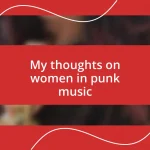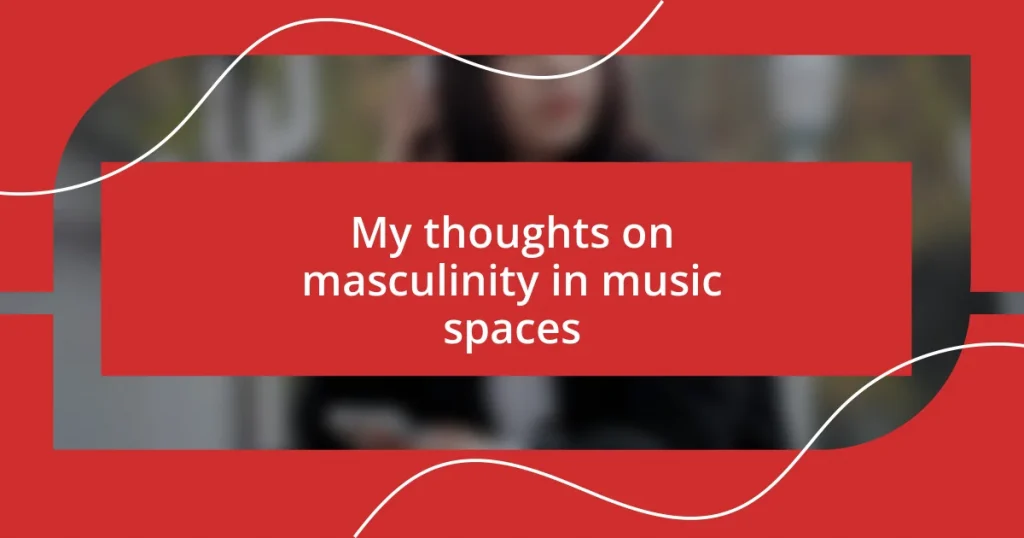Key takeaways:
- Masculinity in music is transforming, with contemporary artists blending vulnerability and emotional expression, challenging traditional stereotypes of strength and stoicism.
- Diverse voices and collaborative songwriting enhance the creative process, fostering inclusion and a broader narrative in music.
- Promoting safe spaces in music venues encourages emotional connection and openness, creating an environment where individuals feel comfortable expressing their vulnerabilities.

Understanding masculinity in music
Masculinity in music is often portrayed through specific themes—strength, dominance, and emotional stoicism. I remember listening to many rock anthems during my teenage years, where the lyrics embodied bravado and a certain toughness. It made me wonder, can vulnerability in music challenge those norms?
In exploring this topic, I’ve noticed that genres like hip-hop and country often represent different facets of masculinity. For instance, I’ve encountered rap lyrics that oscillate between aggression and heartfelt storytelling, revealing a complex tapestry of male identity. Why is it that some artists feel pressured to mask their emotions, while others embrace them openly?
When diving into the sonic elements of masculinity, I’ve found that instrumentation often supports or contradicts lyrical themes. For example, heavy guitar riffs may contribute to a perception of toughness, but softer melodies can evoke feelings of tenderness that we rarely associate with traditional masculinity. How does this duality affect our understanding of what it truly means to be a man in today’s music landscape?

Redefining masculinity in contemporary music
Redefining masculinity in contemporary music is truly a remarkable journey. I’m struck by how many artists are now incorporating vulnerability into their lyrics, challenging the old stereotypes. For instance, when I listen to songs by artists like Lil Nas X, I’m reminded of how effortlessly he blends bravado with heartfelt emotions. It takes courage to embrace one’s true self in a genre that has often celebrated hypermasculinity. This evolution sparks the question: can openly expressing one’s feelings become the new standard of strength in music?
I can’t help but recall how music has shifted since my youthful days. Back then, songs about heartbreak often portrayed men as stoic, but today’s ballads give space for raw and emotional expressions. When I hear a track by artists like Hozier or Sam Smith, I feel a deep connection. They lay their vulnerabilities bare, inviting listeners to do the same. Isn’t it fascinating how these artists encourage their male listeners to reflect on their own experiences, promoting a healthier view of masculinity?
This transformation is evident across different genres, where emotion can redefine masculinity completely. In contrast to the traditional raucous sounds, I’ve noticed softer indie melodies inviting men to embrace sensitivity. It’s refreshing! The juxtaposition of gritty rap and ethereal pop illustrates a broader spectrum of masculinity, revealing that strength can coexist with vulnerability. Is a world where men are free to express both strength and sensitivity achievable through music?
| Traditional Masculinity Themes | Contemporary Masculinity Themes |
|---|---|
| Strength and Dominance | Vulnerability and Emotion |
| Stoicism | Open Expression |
| Aggression in Lyrics | Heartfelt Storytelling |

Strategies for inclusive music environments
Creating inclusive music environments requires intentional strategies that foster connection and openness. One approach I’ve seen work effectively is the integration of diverse voices in both the songwriting and performance processes. When I attended a local songwriting workshop, I was amazed by how collaborative efforts brought together people with varied backgrounds. We all learned from each other, and it shaped a richer, more expansive narrative within the music we created together. Isn’t it incredible how different perspectives can enhance the creative process?
Another vital strategy involves educating audiences about the importance of inclusivity in music. I remember attending a concert where the artist took a moment to discuss their journey with mental health, encouraging listeners to be more open and supportive. That simple act broke down barriers and allowed for authentic conversations. If musicians can use their platforms to spark dialogue, why shouldn’t we embrace opportunities to educate ourselves and each other in our local music spaces?
Lastly, promoting safe spaces in music venues can significantly impact how people engage with music and one another. I once visited a small club that specifically designated areas for those who might feel overwhelmed, providing a more comfortable experience. The atmosphere shifted instantly; it was evident that when individuals feel safe, they’re more likely to express themselves freely. Wouldn’t it be wonderful if every music environment could adopt such practices, helping to normalize vulnerability and emotional connection among all attendees?













